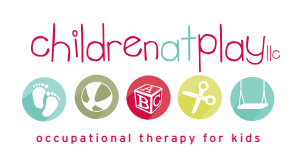What is sensory integration? All of our senses work together. Each sense works with the others to form an organized and accurate picture of: who we are physically, where we are in space, and what is going on around us. Sensory integration is a critical function of the brain that is responsible for producing this complete picture. For most of us effective sensory integration occurs automatically, unconsciously, and without effort. For others, the process is inefficient and demands effort and attention with no guarantee of accuracy. This makes life much more challenging.
What does it feel like to have sensory challenges? Have you ever tripped walking down the stairs because you thought there was one more? Or picked up something you thought was heavy and ended up dropping it because it was light? Have you ever been driving and needed to turn down the radio so that you could think? This is a glimpse into what it is like when our sensory systems are not working together properly. For many children, this is what every minute of every day feels like.
All children on the autism spectrum have challenges with sensory integration, though not all people with sensory integration challenges have autism. Many children have difficulty with organizing the world around them and it may effect their ability to interact appropriately.
Children who have difficulty with sensory integration may be extremely fearful of movement, or seek out intense movement opportunities. This is because each child’s sensory system is unique and constantly changing; each system can be over or under responsive. The effects of poor sensory integration can interfere with academic learning, socialization, daily living skills, emotional health, and self-esteem.
How can we help? Sensory integration treatment is most effective when implemented by an occupational therapist with experience using a sensory integration approach. To the untrained eye therapy looks a lot like play—and it is play that is designed by the children themselves! It is vitally important to use the types of activities that the child is seeking, to engage them into sensory play. Children seek out what their body needs developmentally, so it is the job of a good occupational therapist to provide the just right challenge, and engage the child in appropriate play. It is this active involvement and exploration that enables the child to become a more mature, efficient organizer of sensory information.
My groups are aimed at using sensory rich experiences to regulate children’s nervous systems, and help them to engage with peers. Children will challenge their balance and motor planning with obstacle courses, work on self-regulation with swinging, and improve their body awareness with climbing and crashing. These movement-based activities will help children to engage with peers and build new skills. Click here to get more information about individual therapy or small groups.
Blog Posts
Children at Play provides children’s occupational therapy services in Anne Arundel County. Our Blog covers sensory processing (SPD), sensory integration techniques, autism therapies, home exercise programs, and more.
Children at Play
Occupational Therapy for Kids
Children at Play provides occupational therapy services in Annapolis and throughout Anne Arundel County. We use a sensory integration approach to kids’ therapy and treat children with a variety of special needs.
Children at Play, LLC | 205 Ridgely Avenue, Annapolis, MD, 21401, United States

